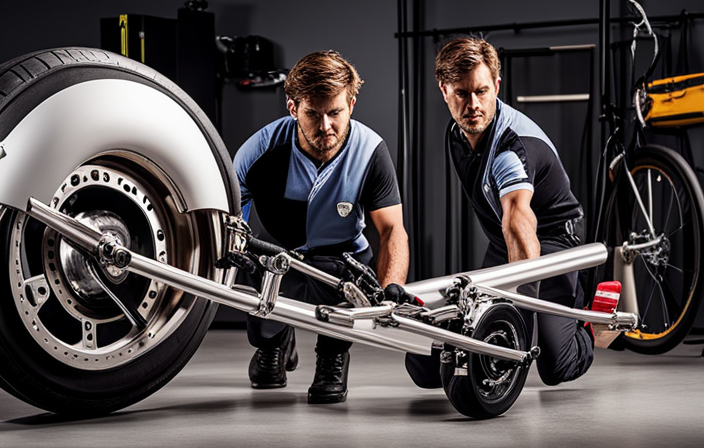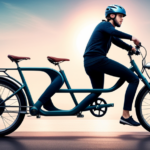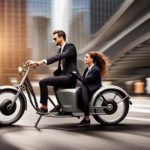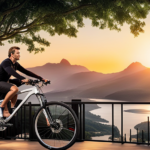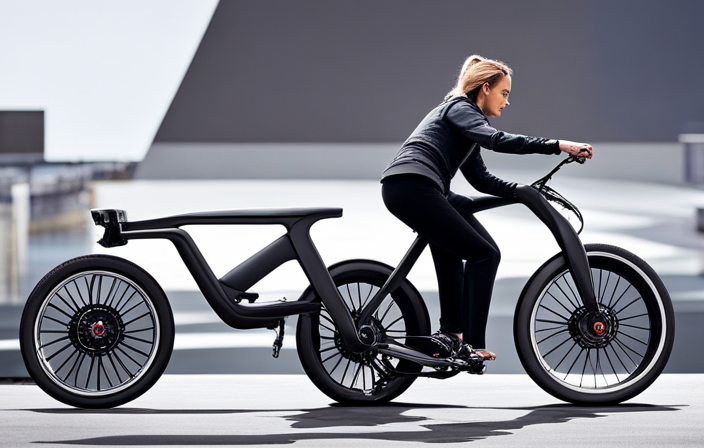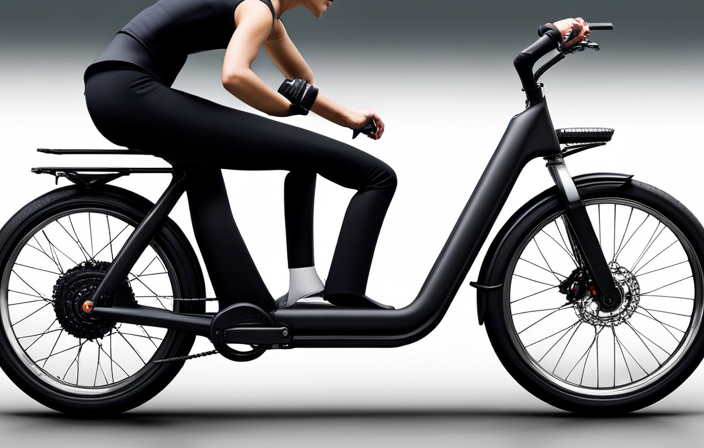I’ve always loved biking, but recently I’ve been looking for a way to give my rides an extra boost. That’s when I discovered the world of electric motors for bikes.
The idea of effortlessly gliding up hills and increasing my speed without breaking a sweat intrigued me. So, I set out on a mission to learn how to mount an electric motor on my bike.
In this article, I will share with you the step-by-step process, from gathering the necessary tools to enjoying the benefits of your electric-powered bike.
Get ready to take your biking experience to a whole new level.
Key Takeaways
- Consider motor specifications, such as power output, voltage, and torque, when gathering tools and materials.
- Explore different motor options, such as hub motors and mid-drive motors, and choose the right one based on terrain and weight.
- Ensure the bike frame is sturdy enough to handle the motor’s weight and vibrations, and consider upgrading to disc brakes for better stopping power.
- Choose a compatible motor mounting bracket, align and secure it to the frame, and then attach the electric motor and connect it to the bike’s drivetrain.
Gather the Necessary Tools and Materials
You’ll need a set of wrenches and some zip ties to mount the electric motor on your bike. Before beginning the installation process, it is important to choose the right motor specifications for your bike. Consider factors such as power output, voltage, and torque to ensure compatibility and optimal performance.
Safety precautions should also be taken into account during the installation. To mount the electric motor, start by securing it to the frame of your bike using zip ties. Make sure the motor is positioned securely and tightly to avoid any movement or vibrations while riding.
Next, connect the motor to the bike’s drivetrain using a chain or belt drive, depending on the motor type. During the installation process, it is crucial to follow safety precautions. Ensure that the bike’s electrical system is turned off and disconnected before working on the motor. Use insulated tools and gloves to protect yourself from any electrical shocks.
Double-check all connections and fastenings to avoid any accidents or malfunctions while riding. By taking these necessary precautions and using the right tools, you can successfully mount an electric motor on your bike. Now, let’s move on to the next section to learn how to choose the right electric motor for your bike.
Choose the Right Electric Motor for Your Bike
To ensure proper performance, it’s important to select the correct electric motor for your bicycle. When choosing the right electric motor for your bike, there are several factors to consider. Here are some key points to keep in mind:
-
Power: Determine the power output you need based on your intended use. Consider factors such as the terrain you will be riding on and the weight you will be carrying.
-
Motor Options: There are different types of motors available, including hub motors and mid-drive motors. Each has its own advantages and disadvantages.
-
Hub Motors: These motors are located in the wheel hub and provide direct power to the wheel. They are simple to install and maintain but may affect the balance of your bike.
-
Mid-Drive Motors: These motors are positioned at the crankshaft, providing power directly to the drivetrain. They offer better balance and are more efficient, but they can be more complex to install.
-
Battery Compatibility: Ensure that the motor you choose is compatible with the battery you plan to use. Consider factors such as voltage and capacity to ensure optimal performance.
By carefully considering these factors and comparing different motor options, you can select the electric motor that best suits your biking needs.
Once you have chosen the right electric motor, it’s time to prepare your bike for the motor installation by following the next steps.
Prepare Your Bike for the Motor Installation
Before installing the motor, make sure your bicycle is properly prepared. To ensure a successful motor installation, it is crucial to modify your bike accordingly.
Firstly, inspect your frame to ensure it is sturdy and can handle the additional weight and vibrations of the motor. Check for any cracks or damages that may compromise the integrity of the frame.
Secondly, evaluate your braking system. Upgrading to disc brakes is highly recommended as they provide better stopping power and heat dissipation, crucial for the added speed and weight.
Additionally, it is important to reinforce the rear dropouts and axle to support the motor’s torque. This can be achieved by using torque arms or upgrading to a stronger axle.
Lastly, consider the electrical system. Ensure that your bike has a suitable battery placement and that all the necessary wiring and connectors are in place.
Now that your bike is ready for the motor installation, let’s move on to the next step: installing the motor mounting bracket.
Install the Motor Mounting Bracket
Now that everything’s set, it’s time to attach the bracket for your motor. Choosing the right bracket is crucial to ensure a secure and stable installation. You want to make sure it is compatible with your bike frame and the size of your motor. Take into consideration factors such as material, weight capacity, and adjustability options.
To ensure proper alignment, follow these steps:
| Step | Procedure | Tools Required |
|---|---|---|
| 1 | Remove the bottom bracket from your bike frame using a bottom bracket tool. | Bottom bracket tool |
| 2 | Place the motor mounting bracket over the bottom bracket shell, aligning the bolt holes. | Allen wrench |
| 3 | Insert and tighten the bolts through the holes, securing the bracket to the frame. | Allen wrench |
| 4 | Double-check the alignment of the bracket to ensure it is parallel to the ground and centered with the bike frame. | Visual inspection |
| 5 | Use a torque wrench to tighten the bolts to the manufacturer’s recommended specifications. | Torque wrench |
Attach the Electric Motor to the Mounting Bracket
Once the mounting bracket is securely attached, it’s time to connect the electric motor to it. This step is crucial for proper functioning and stability of the motor on the bike.
To begin, locate the motor’s mounting holes and align them with the corresponding holes on the bracket. Use the provided bolts and washers to secure the motor in place. It is important to tighten the bolts firmly, but be cautious not to over-tighten as this can damage the motor or bracket.
When attaching the motor, it is essential to follow proper mounting techniques. Ensure that the motor is centered and level with the bracket to prevent any imbalances or misalignment. Double-check that the mounting bolts are securely fastened, as loose connections can lead to vibrations or even detachment during operation.
If you encounter any issues during this process, there are troubleshooting tips to help. Firstly, ensure that the mounting holes on the motor and bracket are aligned correctly. If they are not, adjust the position accordingly. Additionally, check for any obstructions or debris that may be preventing the motor from fitting properly onto the bracket.
With the electric motor securely attached to the mounting bracket, the next step is to connect it to the bike’s drivetrain. This will allow the motor to transfer power to the bike’s wheels and propel it forward efficiently.
Connect the Motor to the Bike’s Drivetrain
To ensure a smooth and efficient transfer of power, you’ll want to connect the motor to your bike’s drivetrain by following these steps:
-
Begin by locating the motor’s output shaft and the bike’s drivetrain. Ensure that both are easily accessible and aligned properly.
-
Next, find the appropriate gear on the drivetrain where the motor’s power can be optimized. This gear should be able to handle the motor’s output without causing any strain or damage.
-
Once the gear is identified, use a suitable chain or belt to connect the motor’s output shaft to the chosen gear on the drivetrain. Make sure the chain or belt is properly tensioned to ensure smooth power transmission.
By connecting the motor to the bike’s drivetrain, you are effectively harnessing the motor’s power and integrating it seamlessly into your biking experience. This allows for a more efficient and enjoyable ride, as the motor’s power output is optimized to work in harmony with your bike’s drivetrain.
With this connection in place, you can now move on to the next step of the installation process, which involves installing the battery and controller.
Install the Battery and Controller
Make sure you have the appropriate tools ready to install the battery and controller.
First, let’s talk about the battery position. Find a suitable spot on your bike where you can securely mount the battery. It should be easily accessible, but also protected from any potential damage. Take into consideration the weight distribution as well, as you want to maintain balance while riding. Once you have chosen the battery position, use mounting brackets or straps to securely attach it to your bike frame.
Now, let’s move on to the controller installation. Locate a convenient area on your bike where the controller can be mounted. It should be close to the battery and easily accessible for any adjustments or maintenance. Ensure that the controller is protected from any elements such as water or dust, as this can affect its functionality. Use the appropriate mounting brackets or straps to secure the controller to your bike frame.
With the battery and controller properly installed, it’s time to connect them to the motor. This step is crucial as it enables the flow of power from the battery to the motor. Follow the manufacturer’s instructions to make the necessary connections, ensuring that all wires are securely attached and properly insulated. Once everything is connected, double-check the connections to ensure they are correct and secure.
In the next section, we will discuss how to connect the battery and controller to the motor, completing the electrical setup of your electric bike conversion.
Connect the Battery and Controller to the Motor
Now that the battery and controller are securely installed, it’s time to connect them to the motor. This step is crucial in completing the installation process and ensuring the proper functioning of the electric motor on your bike. Follow these three steps to make the necessary battery connections and controller wiring:
-
Identify the motor wires: Start by locating the motor wires on your electric bike. Typically, these wires are color-coded, with red and black indicating positive and negative terminals, respectively. Ensure that you have a clear understanding of which wires correspond to which terminals.
-
Connect the battery: Take the positive wire from the battery and connect it to the positive terminal on the motor. Similarly, connect the negative wire from the battery to the negative terminal on the motor. Make sure the connections are secure and free from any loose or exposed wires.
-
Wire the controller: Connect the controller to the motor by matching the corresponding wire colors. For example, connect the red wire from the controller to the red wire on the motor, and the same for the black wires. Double-check the connections to ensure accuracy.
Test the Electric Motor and Check for Proper Functioning
After connecting the battery and controller to the motor, it’s important to test the electric motor and check for proper functioning. This step is crucial to ensure that everything is in working order before moving forward with mounting the motor on the bike.
To begin the testing process, I recommend starting with a visual inspection of the motor and wiring connections. Look for any loose or damaged wires, as these can cause issues with the motor’s performance.
Next, you can perform a simple functionality test by turning on the motor and observing its behavior. Listen for any unusual noises or vibrations, as these may indicate a problem. Additionally, you can check the motor’s rotation by manually spinning the wheel while the motor is turned on. The wheel should rotate smoothly and without any resistance.
If you encounter any issues during the testing process, there are a few troubleshooting tips you can try. First, double-check all the connections to ensure they are secure. If any wires are loose, tighten them accordingly. You can also check the battery voltage to ensure it is supplying the correct power to the motor.
If all else fails, consult the manufacturer’s instructions or seek professional assistance. Once you have successfully tested the electric motor and ensured its proper functioning, you can proceed to the next section on how to secure and protect the wiring and components.
Secure and Protect the Wiring and Components
To ensure the safety and longevity of your wiring and components, it’s important to securely fasten and protect them from potential damage. Here are some key steps to follow:
-
Wear appropriate protective gear, such as gloves and safety glasses, to protect yourself from potential injuries during the installation process.
-
Utilize weatherproofing techniques to safeguard your wiring and components against the elements. This can include using waterproof tape or heat shrink tubing to seal any exposed connections.
-
Securely fasten the wiring and components to the bike frame using zip ties or mounting brackets. This will prevent them from moving or vibrating during operation, reducing the risk of damage.
Taking these precautions will ensure that your wiring and components are well-protected and secure.
Now, let’s move on to the next section where we will discuss how to adjust and fine-tune the motor’s performance without compromising its integrity.
Adjust and Fine-Tune the Motor’s Performance
You can improve the motor’s performance by making adjustments and fine-tuning its settings. There are several adjustment techniques that can help optimize the motor’s efficiency and power output.
One important adjustment is the controller settings. The controller regulates the motor’s speed and power delivery, and by adjusting parameters such as the voltage or current limits, you can fine-tune the motor’s performance to suit your needs.
Another adjustment technique is to ensure proper alignment of the motor with the bike’s drivetrain. Misalignment can lead to power loss and decrease the motor’s overall efficiency.
Troubleshooting tips include checking for any loose connections or damaged components, as these can also affect performance. Additionally, regularly inspecting and cleaning the motor can help maintain its optimal performance.
By following these adjustment techniques and troubleshooting tips, you can ensure that your electric motor is performing at its best.
Now, let’s consider additional accessories and upgrades that can further enhance your riding experience.
Consider Additional Accessories and Upgrades
Consider adding accessories such as a bike rack or a basket to enhance your riding experience. These upgrades can make your electric bike more versatile and convenient.
Additionally, there are a few key elements to consider when it comes to upgrading your electric bike: the tires and the battery capacity.
Upgrading your bike tires can significantly improve your riding experience. Choose tires that are suitable for the terrain you will be riding on. If you often encounter rough roads or trails, opt for wider and more durable tires with good traction. On the other hand, if you primarily ride on smooth surfaces, thinner tires with lower rolling resistance might be a better choice for increased speed.
When choosing the right battery capacity for your electric bike, consider your intended usage and the distance you plan to cover. A higher battery capacity will allow for longer rides, but keep in mind that it will also add weight to your bike. Evaluate your needs and find a balance between battery capacity and weight that suits your preferences.
Learn How to Ride and Control Your Electric Bike
Now that you have upgraded your accessories and battery, it’s time to learn how to ride and control your e-bike smoothly. Riding an electric bike requires some specific techniques to ensure your safety and maximize your riding experience.
First and foremost, always wear a helmet and other protective gear, such as knee and elbow pads. Familiarize yourself with the different controls on your e-bike, including the throttle, pedal assist levels, and brakes.
Start by practicing in a safe, open area to get a feel for the bike’s acceleration and braking. When riding, maintain a relaxed grip on the handlebars and keep your feet firmly on the pedals. Be mindful of your speed and always obey traffic laws. Use hand signals to indicate your intentions, especially when turning or changing lanes.
Remember to anticipate and adjust your speed when approaching corners or obstacles. Lastly, be aware of your surroundings and constantly scan for potential hazards. By following these riding techniques and safety precautions, you can enjoy a smooth and safe ride on your electric bike.
Regularly maintaining and servicing your e-bike is crucial to ensure its longevity and optimal performance.
Maintain and Service Your Electric Bike Regularly
To keep your e-bike running smoothly and at its best, it’s important to regularly maintain and service it. Regular maintenance is crucial for ensuring optimal performance and extending the lifespan of your electric bike. Here are some troubleshooting tips and maintenance tasks that should be part of your routine.
Firstly, check your tires regularly for proper inflation and wear. Low tire pressure can affect the bike’s efficiency and handling. Additionally, inspect the brakes for any signs of wear or damage. Adjust them if necessary and replace brake pads when they become worn.
Next, pay attention to the chain and drivetrain. Clean and lubricate the chain regularly to prevent rust and ensure smooth operation. Keep an eye out for any loose or damaged bolts, and tighten or replace them as needed.
It’s also important to periodically inspect the battery and electrical components. Check for any signs of damage or corrosion, and clean the contacts if necessary. Ensure that all connections are secure and that the battery is properly charged.
Lastly, don’t forget to clean your e-bike after each ride. Use a gentle detergent and a soft cloth to remove any dirt or grime, paying special attention to the motor and electrical components.
Enjoy the Benefits of Your Electric-Powered Bike
You’ll love the convenience and freedom that comes with riding your electric-powered bike. With a few key tips, you can maximize your battery life and ensure a smooth and enjoyable ride. Here’s what you need to know:
-
Choose the right gear ratio: Selecting the appropriate gear ratio is crucial for efficient use of your electric motor. A lower gear ratio allows for easier pedaling, while a higher gear ratio provides greater speed. Experiment with different gear combinations to find the sweet spot that balances power and efficiency.
-
Maintain optimal tire pressure: Keeping your tires properly inflated is essential for reducing rolling resistance and maximizing battery life. Check your tire pressure regularly and inflate them to the recommended PSI. This will not only improve your bike’s performance but also extend the life of your battery.
-
Utilize pedal-assist mode: Take advantage of the pedal-assist mode on your electric bike. This feature allows you to conserve battery power by supplementing your pedaling efforts with the motor’s assistance. By pedaling along with the motor, you can extend your battery life and enjoy a longer ride.
-
Charge your battery properly: To ensure the longevity of your battery, follow the manufacturer’s guidelines for charging. Avoid overcharging or leaving your battery at low levels for extended periods. It’s best to charge your battery when it reaches around 20-30% capacity and disconnect it once it reaches 80-90%.
Frequently Asked Questions
How long does it typically take to mount an electric motor on a bike?
On average, it takes about 2-3 hours to mount an electric motor on a bike. However, the time required can vary depending on the complexity of the installation and the individual’s familiarity with the process.
Common challenges include properly aligning the motor with the bike frame, securing it firmly in place, and ensuring all electrical connections are correctly made.
It is important to follow the manufacturer’s instructions and take necessary safety precautions during the installation process.
Are there any specific safety precautions that need to be taken during the motor installation process?
During the motor installation process, it’s crucial to prioritize safety precautions to avoid potential risks.
Firstly, ensure the bike is stable and secure before beginning the installation.
Use appropriate safety gear, such as gloves and goggles, to protect against any accidental injuries.
Additionally, be cautious of exposed wires and connectors to prevent electrical hazards.
Can any bike be converted into an electric bike, or are there certain requirements that need to be met?
When it comes to electric bike conversion, there are certain requirements that need to be met.
Not all bikes can be easily converted into electric bikes. The key factors to consider are the frame design and size, as well as the availability of space for the battery and motor.
Additionally, the bike should have compatible wheel and tire sizes to ensure a smooth and stable ride.
It is crucial to choose a bike that meets these requirements for a successful electric bike conversion.
Is it possible to remove the electric motor and revert the bike back to its original state?
Yes, it’s possible to remove the electric motor and revert the bike back to its original state.
For example, I recently worked on a bike equipped with an electric motor that was easily removable. By detaching the motor and disconnecting the necessary wiring, the bike returned to its original form.
It’s important to note that the reversibility of electric motor installation does not significantly impact the bike’s performance when the motor is not in use.
Are there any legal restrictions or regulations regarding the use of electric bikes in certain areas?
There are indeed legal implications and regulations governing the use of electric bikes in various areas. These regulations are designed to ensure the safety of riders and pedestrians and to address concerns about the environmental impact of electric bikes.
Some areas may require registration, licensing, or insurance for electric bikes. Additionally, there may be restrictions on where electric bikes can be ridden, such as designated bike lanes or paths.
It is important to familiarize oneself with the specific regulations in your area to ensure compliance.
Conclusion
In conclusion, mounting an electric motor on a bike can be a thrilling and rewarding experience. As I cruised down the streets on my newly electrified bike, I felt a surge of power and freedom.
The metaphorical transformation was like a caterpillar turning into a butterfly, as my bike became a new and improved version of itself. With the right tools, materials, and knowledge, anyone can enjoy the benefits of an electric-powered bike and explore the world with ease.
So, get ready to unleash the potential of your bike and embrace the electrifying journey ahead.
